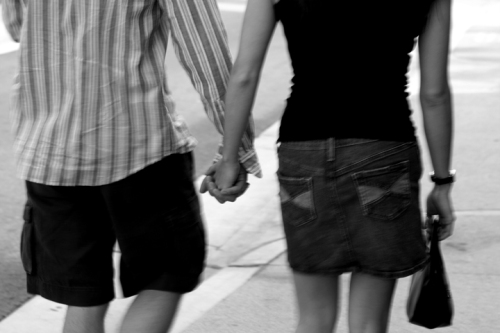Heterosexuality: totally made up in the mid-19th century by a queer guy
by MJ Lyons
On this “National Coming Out Day,” I would like to remind you that heterosexuality is totally made up. Yup, completely fabricated; quite recently, actually, in a letter on May 6, 1868. And it was actually made up by a queer man.
Of course, the behaviour of same-sex sex has existed for… well, a while… but the term, the meaning behind the term and all the baggage that comes with it (both for heterosexuals and queer/trans people) is a very recent development.
If you’re interested in the history of the heterosexual, check out my recent History Boys “heterosexuality triptych” on DailyXtra.com, three pieces on how the term came to be, the man behind it and why it really, really caught on. There’s of course an incredibly larger amount of things to say, but I hope this captures three important instances in the development of our much-beloved straights.
Click through the links or images for the full article.

Beautiful illustration by Sissydude/John Webster
What is heterosexuality? We’re always questioning what homosexuality is — nature versus nurture, a biological inevitability or a social problem, something that’s existed forever or something completely made up — but we rarely stop to ask ourselves, What makes a heterosexual? Where did they come from? It may surprise many of our staunchly straight friends, but heterosexuals didn’t actually exist until the mid-19th century.
“Not so straightforward” explores the roots of the concept and the word “heterosexual,” and where it made it’s first appearance. Funny enough, to the man who invented the term, heteros were just as likely to have homosexual or non-procreative sex as their homosexual counterparts! Those perverts!

Beautiful illustration by Yigi Chang
Heterosexuality was invented by a queer person. You might find this fact uncomfortable, upsetting or hilarious, but it’s true. The concepts of the “heterosexual” and the “homosexual” were first used in a letter between two pioneering gay-rights activists that was written on May 6, 1868. The man who coined the terms, along with a few others for fornicators and masturbators that didn’t catch on, was Austrian-born Hungarian writer Karl-Maria Kertbeny.
Kertbeny wore a lot of hats: journalist, nationalist, literary champion, spy, botany enthusiast, legal reformist and, publicly, heterosexual. However, as Hungarian sociologist Judit Takacs writes in her essay “The Double Life of Kertbeny,” he was something of an unreliable narrator when it came to the official story of his life — especially where his sex life was concerned.
“Not so straightforward, Part 2” takes a look at the man behind “heterosexuality,” and how it’s very likely that by modern terms he’d probably be considered gay–maybe bisexual, if you’re feeling historically generous. He pined over rent boys, agonized over STIs and feared being spied on while trying to make his mark on the world. I think we can all relate.

Beautiful illustration by Yigi Chang
Heterosexuality is one of the most successful brands that has ever existed. When you join the ranks of the heterosexuals, you become a member of an exclusive club that has a myriad of social, legal and logistic benefits. Heterosexuals can travel anywhere, get any job, claim mastery over anything and never be questioned about their legitimacy as a person. Well, unless you’re a heterosexual woman. Or a heterosexual person of colour. Or a heterosexual transgender person. Or a heterosexual poor person . . . okay, so there are some conditions, but it’s mostly a good gig!
Of course, the market preceded the brand. Consider that Emily Brontë’s Wuthering Heights, taught in my high school as the epitome of romanticism — a book about crazy, incestuous heteros — preceded the term “heterosexual” by more than 20 years. Even after Karl-Maria Kertbeny employed the word in a letter to a colleague in 1868, the word didn’t begin to filter into the mainstream lexicon until it was adopted by Austro-German psychiatrist Richard von Krafft-Ebing.
“Join club hetero today!” explores how the concept of heterosexuality really caught on, and how important it was to culture in post-war capitalism. Think of every movie you’ve seen since you were born. Think of ever book you’ve read. Think of every advertisement you’ve seen. Think of every time you watched heterosexuality, real or imagined, play out in front of your eyes, and what that was selling to you. Think of how, in your grad school years, there was probably the expectation that you’d eventually couple up with a partner of the opposite sex, pop out some kids, and then repeat the process. That, my friends, is the powerful brand of heterosexuality!
The probably well-meaning but ever-controversial Human Rights Campaign explains that, “27 years ago, on the anniversary of the National March on Washington for Lesbian and Gay Rights, we first observed National Coming Out Day as a reminder that one of our most basic tools is the power of coming out.” They continue:
Coming out – whether it is as lesbian, gay, bisexual, transgender, queer or allied – STILL MATTERS. When people know someone who is LGBTQ, they are far more likely to support equality under the law. Beyond that, our stories can be powerful to each other.
That may be the case, but just remember we live in societies that still treat queer- and (especially) trans-identified people as second class citizens (or worse); where coming out can have a number of social and financial ramifications; where simply existing as a trans-identified person, ESPECIALLY a transwoman of colour, significantly raises the likelihood you’ll experience harassment, assault, violence or murder. That’s not to say being a queer- or trans-identified person makes you a victim, but any means, but coming out is a choice. You can come out to one person, two, a million, but the only person coming out to really matters is to yourself; that’s where the real power is.
And also remember that without us queer and trans people the heterosexuals would be nothing.
